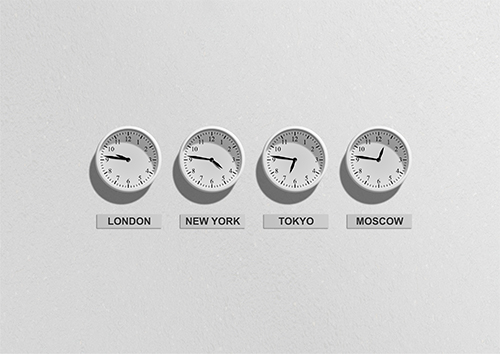You don’t want your business to be located in a traditional, office environment. In fact, you don’t want it to be located anywhere at all.
You want to run a company that operates flexibly.
A company where work isn’t defined by location but by merit.
Where talented team members are handpicked from various locations around the world.
You want a distributed team; where members work together but not in the same physical space.
But how can you ensure that your current team will work effectively together when they’re not, physically, together?
What challenges do they need to overcome?
1. Working in different time zones
Erran Carmel, Dean of the Kogod School of Business at American University in Washington D.C., says that “distance is dead, but time zones aren’t.” He makes a valid point.
Work is no longer constrained by geographical location. Advances in connective technology now enable companies to hire virtual teams from around the world.
Technology, however, can’t perform miracles. Teams that are dispersed internationally will always have to contend with time zones.
Renuka Rayasam, BBC journalist, points out that 10 million knowledge workers have to “coordinate regularly with others across time zones”. That’s a lot of people.
Drawing on his wealth of experience with remote teams, Mutahhir Ali Hayat, a software developer at Amazon, highlights that this coordination across time zones can be problematic. Particularly, when there is the expectation that some remote team members be available during the working hours of the head office.
How can team members ensure communication across different time-zones is fair?
To make cross-continental communication fair, distributed company and global furniture provider Steelcase came up with a strategy of “sharing the burden of 24/7 across the team
This strategy involved creating a rotating meeting schedule for the team.
Donna Flynn, a Director at Steelcase, explains that “every month, each team member has one evening, one mid-day, and one early morning meeting, and misses one meeting that falls in the middle of their night.”
The rotating schedule is a useful option to consider in a distributed team as it prevents the same team members from repeatedly taking video calls in the middle of the night.
“Sharing the burden” is just one means of making international communication fair.
Another strategy to make communication fairer is to split a large team into smaller, communicative sub-units.
Annie Spratt, Community Manager of Unsplash, a royalty-free photography platform, found that when the Unsplash team divided itself into smaller teams, there were less time zone conflicts:
“If you’re trying to do a whole team meeting online, in different time zones, it can be tricky. Now … we have split down into smaller teams with 2 or 3 people, which makes video calls a lot easier.”

Share the burden across time zones
2. Isolation
University researchers, Kirkman, Rosen, Gibson et al. found that the “lack of social interaction in virtual teams resulted in feelings of isolation and alienation in some team members.”
But how can social interaction be increased when distributed team members are not physically together?
Jeff Haden, an editor at Inc, believes the answer lies in leaving your webcam on all day.
Annie Spratt agrees. If she wants social interaction with distributed colleagues, she keeps her webcam on throughout the day.
By switching on her webcam, she is able to talk with co-workers if she wants. And, if she doesn’t want to talk, the background noise of people working keeps her company.
> Find out more about anywhere.link, video collaboration software that connects anywhere teams <

Switch your webcam on all day
3. Cultural conflicts
Columbia and Stanford University researchers, Williams and O’Reilly, reviewed 40 years’ worth of research into demography and diversity in organisations.
Their findings concluded that “people are attracted to working with and cooperating with those they find similar in terms of “values, beliefs, and attitudes.”
Therefore, conflicts in distributed teams are likely to arise when team members have different cultural backgrounds and consequently have contrasting attitudes and belief systems.
How can distributed teams limit such cultural conflict?
Mortensen and Hinds, also from Stanford University, suggest that a “shared identity (shared backgrounds, visions, values, strategic priorities, goals etc.) may help distributed teams to better manage conflict.”
But how can you help your team develop a shared sense of identity? Remind your team of everything they have in common.
Mortensen suggests that to develop a sense of shared identity in a distributed team, you should continually “remind your team that [they] are all working to the same end and that [they] need each other to get there.”

Reach a shared vision or viewpoint
Takeaways
Challenges faced by distributed teams and potential solutions:
– Working in different time zones: Rotate your team members on a video call schedule. Ensure that the same team members are not repeatedly having to take 3 am video calls with colleagues from the other side of the word.
– Isolation: Encourage team members to switch their webcam on and leave it on. This way they can communicate with colleagues anywhere in the world, whenever they want.
– Cultural conflicts: Continually remind your team that they are all working towards a common goal and that they need to help each other to get there.
Interested in going anywhere?
Get advice straight to your inbox:


